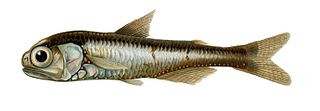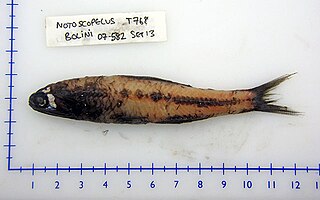
Lanternfish are small mesopelagic fish of the large family Myctophidae. One of two families in the order Myctophiformes, the Myctophidae are represented by 246 species in 33 genera, and are found in oceans worldwide. Lanternfishes are aptly named after their conspicuous use of bioluminescence. Their sister family, the Neoscopelidae, are much fewer in number but superficially very similar; at least one neoscopelid shares the common name "lanternfish": the large-scaled lantern fish, Neoscopelus macrolepidotus.

Electrona is a genus of lanternfishes in the family Myctophidae.

Warming's lantern fish, Ceratoscopelus warmingii, is a lanternfish of the family Myctophidae, found circumglobally in both hemispheres, at depths of between 700 and 1,500 m during the day and between 20 and 200 m at night. Its length is about 8 cm (3.15 in).

Myctophum affine, the metallic lanternfish, is a species of lanternfish native to the Atlantic Ocean. Myctophum affine grows to a length of 7.9 centimetres (3.1 in) SL.

Electrona subaspera, also known as the rough lanternfish, is a marine, mesopelagic fish. This species is usually found between 0–200 metres (0–656 ft) at night. It occurs circumglobally between the subtropical convergence and the Antarctic polar front, in the southern Atlantic, Indian, and Pacific Oceans.
Flashlight fish is a common name for several fish and may refer to:

Myctophum punctatum is a species of mesopelagic fish in the family Myctophidae. Its common name is spotted lanternfish, sometimes spelled spotted lanterfish. It is found in the Northern Atlantic and in the Mediterranean at depths down to 1000m. It is one of the dominant species in midwater assemblages near the Mid-Atlantic Ridge.

Notoscopelus bolini is a species of lanternfish in the family Myctophidae. It is found in the North Atlantic Ocean and the Mediterranean Sea. It was first described in 1975 by the American ichthyologist Basil Nafpaktitis and named in honour of the American marine biologist Rolf Ling Bolin who had reviewed the genus in 1959.

The headlight fish is a species of lanternfish in the family Myctophidae. It is also sometimes referred to as the headlight lanternfish, or even the lanternfish, though it is not the only species to be called this.

Cocco's lantern fish, also called Gemellar's lanternfish, is a species of lanternfish.

The white-spotted lantern fish, also called Rafinesque's lanternfish, is a species of fish in the family Myctophidae.
Diaphus fragilis, the fragile lantern fish, is a species of lanternfish found in tropics worldwide.
Diaphus mollis, the soft lanternfish, is a species of lanternfish found in the Atlantic and Indian Oceans.

Diaphus termophilus, also known as Taaning's lantern fish, is a species of lanternfish. It occurs in all oceans between about 52°N and 48°S.
Diaphus subtilis is a species of lanternfish found in the Atlantic Ocean.
Diaphus meadi, also known as Mead's lanternfish, is a species of lanternfish that is found almost worldwide.

Diaphus dumerilii, also known as Dumeril's lanternfish, is a species of lanternfish found in the eastern Atlantic Ocean.
Diaphus taaningi, the slopewater lanternfish, is a species of lanternfish found in the eastern Atlantic Ocean.
Diaphus perspicillatus, the transparent lantern fish, is a species of lanternfish found worldwide.
Lobianchia dofleini, also known as Dofleini's lantern fish, is a species of lanternfish. It is found in the Atlantic Ocean.















